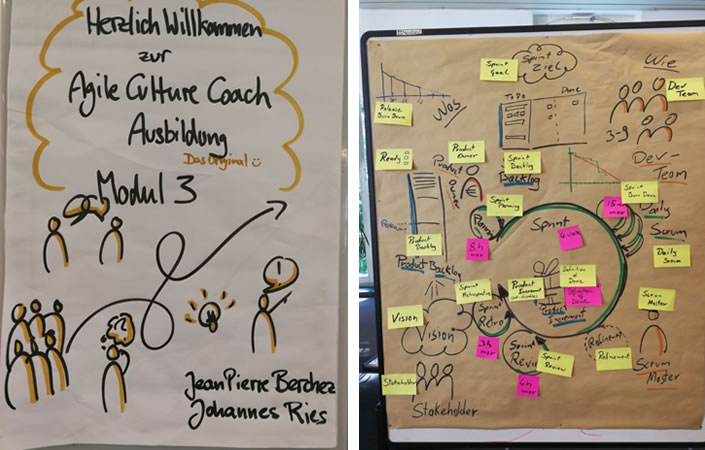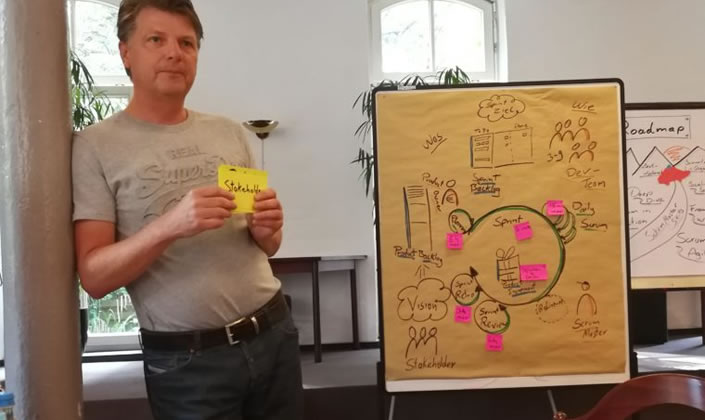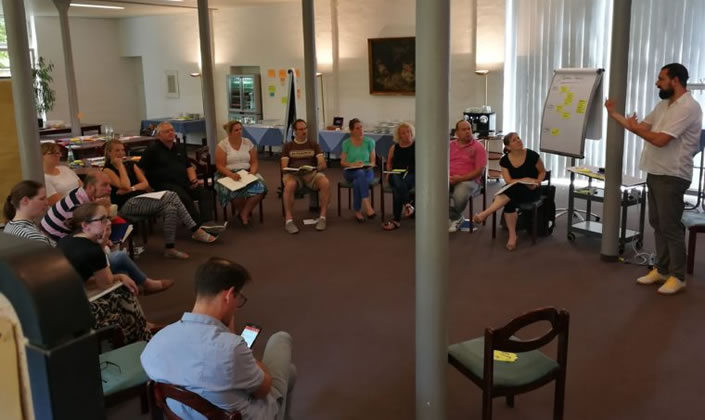
Does »Agility« and »Controlling« fit together? The big Munich »Controller Congress« had the title »Agile Controlling in the digital reality – managing upheavals successfully?«. I received a fantastic offer: Deep immersion into the subject during a professional training to the »Agile Culture Coach«. In contributions to the ICV ControllingBlog, I report about it. Today: Module 3: Agile Methods and Scrum.
The first module 1 of the training, as described here, was focused on »Agile Leadership and Participation«, Module 2 – on the »Agility and Personality« followed in May. Here »The Construct Personality« became the center of interest, and among others we discussed structural and personality tests.
In July Module 3 presented the topic »Agile Methods and Scrum«. Various agile formats, design thinking, strategy tools and conference formats were discussed. We, 14 participants, should learn the logic of agile methods and the most important tools associated with them. Objective: To be able to build Scrum teams in organizations and accompany them.
In the main topic Scrum it was at the beginning about the Scrum framework with roles, artefacts, rules etc., dealing with questions such as emergent architecture and reporting. Scrum teams and the tasks of the Scrum Masters were dealt with in detail. It was also important to pay attention to the fact that another goal of this module was to get the necessary knowledge for a successful examination to the Professional Scrum Master.
For trainers the organizer, SYNNECTA, invited two renowned experts: Jean Pierre Berchez and Johannes Ries. They led us sovereignly and captivatingly through a whole mountain of new knowledge. Berchez (picture) has been familiar with Scrum since 1995. The certified Scrum Trainer and Coach organized a.o. Scrum certification workshops with the inventors of Scrum, Dr. Jeff Sutherland and Ken Schwaber. Johannes Ries helps people in organizations find answers for business planning, strategy and organizational development in the unpredictable VUCA world.

Potentials of teams
Agile teams are VUCA-resilient if they have prepared themselves for any situation by a high degree of diversity and interdisciplinarity. Teams or projects can quickly »swell« and the »task jungle« can quickly become confusing. The team members often work at different locations, possibly even in various time zones. Effective tools for task management are essential.
For »agile project management« the training module focused on Scrum – an agile method for complex development projects. Scrum is effective by combining the ability of the stakeholders to unite their potential. The Scrum concept works for various, clearly defined positions such as product owner, development team, Scrum Master. The Scrum Master, selected from the development team, supports and monitors the entire process for example. The workflows are clearly structured, in a jointly maintained task board and the completed tasks are transparent to the team. We participants learn about different Scrum tools – and try them out on our own fictitious Scrum project. For example, the »Product Backlog«, a list of user stories or requirements maintained by the product owner. There are e.g. the »sprints« – each increment is a time box of as a rule 30 calendar days – and there is the »Sprint Backlog«, a list of tasks that are required to implement the Sprint’s selected product backlog requirements in deliverable product.
Also our training module 3 was divided into (four) sprints. In Sprint 1 we built teams, where we could actively experience Scrum during these two days. In Sprint 2, as a »Scrum Team Member«, we learned to understand the »why« for agile and Scrum, so that we could later use it in our organizations (Why agility? #Cynefin #VUCA #Simulation). In Sprint 3, we learned how to use the Scrum framework effectively (and pass the certificate validation) (#Roles #Practices/Tools #Events #Artefacts #Myths). And in Sprint 4, our teams ran a Scrum practice project where we could experience Scrum in action (#Vision #Product Backlog with User Stories #Prioritizing the Backlog Items #Estimating).
Obvious, but not simple
I understand now the agile procedures and Scrum: by clear prioritizations, e.g. the products that the customer most urgently needs are made available. Deliverable (sub)products are disclosed in e.g. monthly intervals, at the end of each iteration. In the entire product development, the level reached is always transparent at all times. If something goes in the wrong direction or obstacles arise, the entire team can quickly react during the daily checks. This frequent, regular feedback in the daily rhythm ensures continuous improvements, both in the process and in the product.
The basic principles sound plausible, but Scrum is certainly not simple. Trainer and also some students with first Scrum experiences made it clear in exciting discussions that the practical implementation in complex system landscapes and organizations is anything but easy. In practice, there are no homogeneous system environments. And the biggest challenge I see in the necessary changes of the organization for a suitable framework.

(Reports from other modules of the Agile Culture Coach training will follow.)
Hans-Peter Sander blog.icv-controlling.com
